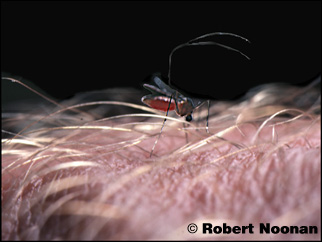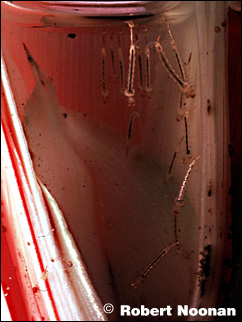
Larvae of over 200 mosquito species have been found in water in bromeliad tanks in the neotropics. Some are specialists to that habitat while others are generalists which occur in various habitats (10). Among the specialists are larvae of certain Anopheles species whose adults are important transmitters of malaria.
Cleanliness of bromeliads shipped from the neotropics is essential, not just to avoid importation of pests that may damage bromeliads and other plants, but also to avoid importation of mosquitoes (especially as eggs).
Bromeliads (and other plants) imported to the USA from abroad are required to undergo agricultural inspection (for "plant pests" and "plant diseases") by USDA-APHIS at ports of arrival under two U.S. laws (31, 32). "Plant pests" are defined as pests of plants, though plants which are or might become pests (i.e., weeds) also are barred by law. USDA-APHIS also has the task of barring entry to "animal pests" and "animal diseases" which are defined as pests and diseases of livestock. In general, if "plant pests" or "plant diseases" are found, the infested plants are destroyed or fumigated. The efficacy of fumigation in killing mosquito eggs in bromeliads has not been determined.
The U.S. Surgeon General is empowered to regulate movement of transmitters (vectors) of disease of humans across state and national boundaries (34). However, inspection of plants currently is not made by U.S. Public Health Service employees. Eggs, larvae, pupae, and adults of mosquitoes which are actual or potential transmitters of disease of humans are not reportable by USDA-APHIS plant inspectors.
Wyeomyia mosquitoes
Only two native Florida mosquito species have larvae specialized for existence in bromeliad tanks: Wyeomyia vanduzeei and Wyeomyia mitchellii. Adult females of both species bite warm-blooded animals, including man. This causes pruritis (itching) rather than pain. The peak of the biting cycle is in late afternoon, in contrast to many mosquitoes of other species which bite mainly after dark (4). These two Wyeomyia species are not known to vector any disease of humans, though some neotropical Wyeomyia species vector Wyeomyia virus and Ilheus encephalitis virus. Because of this, Wyeomyia vanduzeei and Wyeomyia mitchellii may be looked upon simply as pests of man (albeit with some suspicion until research is more complete). However, in southern Florida they are common and are important pests (4) throughout the year.
Life cycles and behavior of the two Wyeomyia share generalities with those of other mosquitoes, but there are some important differences. Male and female adults prefer shaded locations and do not fly far (16). They are among the smallest mosquitoes in Florida and their maximum life span is about three weeks. The hind pair of legs (of the three pairs) is held upward and forward over the thorax and head as if to act as an additional pair of antennae. Females lay eggs during daylight hours; they drop the eggs while hovering over bromeliad tanks (15). If the eggs hit the water surface in a bromeliad tank, they hatch in two to three days (11). If the eggs land on dead tree leaves in a bromeliad tank, they may be stranded until washed downward by rainfall, but some can survive stranding for more than three weeks (11).

An adult female Wyeomyia mosquito engorging with blood on a human hand (Photo: Robert Noonan)
Larvae feed by filtering small particles of food, mostly at the water surface, and they take a minimum of about two weeks to develop to the pupal stage; this is more than twice as long as many pest mosquitoes in Florida. Pupae take four to five days to develop into adults.

Wyeomyia mosquito larvae in a bromeliad tank (Photo: Robert Noonan).
A remarkable thing about Wyeomyia larvae is their ability to resist starvation for many weeks. Larvae of other mosquitoes, under similar circumstances, would die. Despite decomposed leaves and other materials in bromeliad tanks, the water usually is very clear, suggesting a scarcity of nutrients. Thus, Wyeomyia larvae usually do not have an abundant supply of food; often large numbers exist in tanks with sufficient food for only a few. In some tanks there seems to be intense competition between them for food, and only a few survive. Therefore, the presence of many larvae in bromeliad tanks does not guarantee that many adult mosquitoes will be produced from the bromeliads.
When faced with an inadequate diet, the larvae delay their development. It is to their advantage to do so because extra food may fall into the bromeliad tank from the tree canopy above, and this extra food may enable more of them to complete development to the pupal stage (12). This food-limited survival of the larvae has important implications for most forms of biological and chemical control.
Larvae of these two Wyeomyia species have been studied mainly in tanks of Tillandsia utriculata (11), but are likely to be found in tanks of all imported tank bromeliads. Production from Billbergia pyramidalis is estimated at about 100 adult Wyeomyia per plant per year, based on a survey of plants in Daytona Beach, Tampa, Vero Beach and Miami (17). A yard with 100 plants would therefore be expected to produce about 10,000 adult Wyeomyia per year, about half of which (the females) would attempt to bite.
Adult Wyeomyia do not fly far, so they bother mainly the people on whose land the plants grow, as well as people on neighboring properties, especially in cities. For the grower of bromeliads who does not mind being bitten by mosquitoes, there is no problem; for family, friends and neighbors, there may be a problem. This should be a problem for the owner of the bromeliads to solve, not a problem to be solved at public expense by mosquito control district employees. In general, people enthusiastic about growing bromeliads should be knowledgeable about this problem, take care of their plants, and minimize mosquito production from them. People who have little interest in bromeliads and no time to care for them, would do better not to grow tank bromeliads.
Culex and Aedes Mosquitoes
Larvae of some species of the genera Wyeomyia, Aedes and Culex (and other genera) are specialized for existence in bromeliad tanks in the neotropics, but (apart from Wyeomyia mitchellii and Wyeomyia vanduzeei) these species do not occur in Florida. Instead, larvae of non-specialist species of Aedes, Anopheles, Corethrella, Culex and Toxorhynchites mosquitoes occur occasionally in bromeliads in Florida. In tanks of Billbergia pyramidalis these others together seem to form less than 1% of the total number of mosquito larvae (17) (but see Aedes albopictus).
In central and southern Florida, the two species that did occur most commonly among these few were Culex quinquefasciatus and Aedes aegypti. Females of these two species prefer to place their eggs in small water-containers which are darker in color than bromeliads, such as scrap tires (8). They make some exception to this preference when water in bromeliad tanks is fouled by decaying materials such as grass clippings (17). Although Aedes aegypti is a notorious vector of yellow fever and dengue, the current absence of these diseases from Florida makes this mosquito only a pest.
In northern Florida, where Wyeomyia mosquitoes are uncommon in bromeliad tanks because northern Florida is north of their natural distributional range, two other mosquito species have been found (26). These are Aedes triseriatus and Culex nigripalpus. Aedes triseriatus larvae normally inhabit treeholes, and their presence in bromeliads is uncommon. Culex nigripalpus larvae normally inhabit larger water bodies, such as ditches and stormwater retention ponds, and their presence in bromeliads is uncommon. Culex nigripalpus is the major vector of SLE in Florida.
Aedes albopictus
Aedes albopictus is a recent immigrant to the USA. It arrived, probably as eggs, in scrap tires imported to Houston from Japan. It spread through the southern USA, and was found in Jacksonville in 1986. Further spread was slow at first but, by the end of 1993, it had colonized every county in Florida except Monroe, and had displaced Aedes aegypti from many habitats occupied by that mosquito (37). Aedes albopictus larvae occupy many habitats, including not just water in scrap tires, but vases in cemeteries and water in many other kinds of man-made containers, and treeholes (26).
Officially named the "forest day mosquito", this species has been labelled the "Asian tiger mosquito" by the popular press. Unlike most pest mosquitoes, the females take blood largely during daylight hours, though active further into the evening than are Wyeomyia females. They are more aggressive than Wyeomyia females. Adults are medium-sized, black mosquitoes with white markings.
Unfortunately, females also lay their eggs in bromeliad tanks, and larvae develop there. Tank bromeliads are not common outdoors in north Florida because they are damaged or killed by cold temperatures. However, Aechmea distichantha growing outdoors in Gainesville were found populated by Aedes albopictus larvae, and it was the dominant mosquito in that habitat. It was also found south of Orlando in tanks of Aechmea fasciata, Billbergia pyramidalis, Neoregelia spectabilis, and other species. However, in the south, Wyeomyia larvae were found in nearly 90% of the plants, and Aedes albopictus in fewer than 10%. Perhaps Aedes albopictus is excluded from many bromeliad tanks by the presence of Wyeomyia, because Wyeomyia larvae are highly adapted for living in bromeliad tanks and outcompete the invading species (26); time and data will show whether such competition really occurs.
If Aedes albopictus were only another biting pest mosquito, its arrival would make little difference to bromeliad growers. It would be controlled in much the same way as Wyeomyia, and would be subject to the same kind of limited effectiveness of chemical sprays and fogs used against adults by mosquito control districts (see below). However, in the tropics it transmits yellow fever and dengue. In Japan it transmits dog heartworm, and probably will do the same in Florida. Worse, at a scrap tire dump in Polk County, the virus of EEE was found in adult Aedes albopictus (25). Still worse, Aedes albopictus was shown experimentally to be able to transmit both EEE and SLE (24). It is yet unknown to what extent this mosquito will contribute to outbreaks of EEE and SLE in Florida.
Under these circumstances, an ability of Wyeomyia larvae to outcompete Aedes albopictus larvae in tank bromeliads would be an advantage: it is better to live with a pest mosquito than with a pest mosquito capable of transmitting dangerous diseases. Wyeomyia mosquitoes are likely to be in your yard only if you or your neighbors have tank bromeliads. Aedes albopictus is likely to be in your yard whether or not you have tank bromeliads: a recent survey in Gainesville showed it at all of 16 residential sites that were monitored for 12 weeks (37).